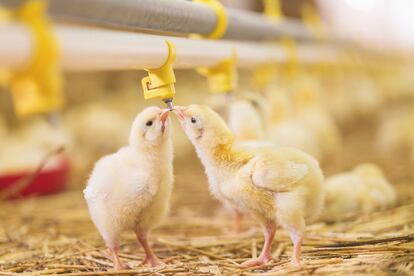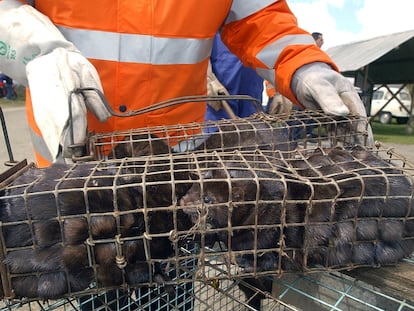The same lab that cloned Dolly the sheep has used gene editing to create chickens resistant to avian flu
The proof of concept still needs to be refined to achieve full protection and address the challenges of practical application

The University of Edinburgh’s Roslin Institute — the animal research center where Dolly the sheep was created — used gene editing to breed chickens that resist infection by the avian flu. A deadly virus for birds that causes great economic losses around the world and can, in some cases, infect and kill humans, the disease has proved difficult for vaccines because the proteins on its surface that are recognized by the immune system change rapidly. A group of British researchers has tested the potential of modifying small sections of chicken DNA to prevent influenza infection, albeit only partially. They published their results today in the journal Nature Communications.
Influenza A needs a protein in chicken cells, ANP32A, to replicate. The team of scientists, led by Mike McGrew, a University of Edinburgh researcher, used the CRISPR editing technique to modify the gene that produces the protein in the chickens’ germ cells, which would enable the birds to pass down the change to their offspring. In this way, animals were created that hardly became infected with influenza when exposed to other infected birds (“9 out of 10 remained uninfected,” according to the study), and they did not subsequently infect other chickens. In a later test, when inoculated with a dose a thousand times higher, five out of ten became infected.
The authors explain that the virus adapted to the change and switched to using two other proteins from the same family (ANP32B and ANP32E) to continue replicating, albeit less efficiently. This prompted the authors to try editing two more genes, thus stopping the progression of the virus in eggs. The researchers were not able to breed chickens with this triple editing, as the authors believe that it would have harmful side effects on the animals’ fertility and their ability to gain weight and their protection against other diseases, which would make its practical application impossible. Even so, the researchers consider it to be proof of concept that this technique can be used to protect against influenza A infection.
Lluis Montoliu, a geneticist at the Spanish National Research Council’s National Biotechnology Center, who was not involved in the study, believes that the result heralds a future in which “animals resistant to influenza infections can be generated, which will require not one but several genetic modifications. Generating more than one modification in the same animal would have been a challenge a few years ago. Now it is much easier with CRISPR gene-editing tools,” he explains. According to the researcher, these techniques make it possible to transfer “mutations that already exist in nature — there are flu-resistant chickens with two mutations in ANP32A — to the production of edited birds. We [can] take advantage of the existing genetic variability to create resistance.”
In addition to introducing protective mutations without creating less productive animals, the researchers also want to ensure that the changes do not push a virus as versatile as the influenza virus in dangerous directions. When they removed the ANP32A protein, the viruses adapted to use proteins from the same family found in humans. As Wendy Barclay, a researcher at Imperial College London and a co-author of the study, explains, “This doesn’t mean that it could infect humans, but we must be careful not to facilitate adaptations of the virus that make it more dangerous than it [already] is.”
Once the problems and risks of editing have been overcome, the practical application would have to resolve other difficulties, as McGrew acknowledges. “You produce about 70 billion chickens a year. To get to that number, you start with about 100,000 at the top of a reproductive pyramid that you expand over four years. You would start by editing the animals at the top so that they would then reproduce [and] pass down the resistance to their offspring,” he explains. “But chickens are not like other animals, where one male mates with 100 females. It’s more like 100 [males] with 100 [females] and introducing that many edits is going to be hard to do,” he acknowledges.
Víctor Briones, a researcher at the Center for Veterinary Health Surveillance of the Complutense University of Madrid (Spain), considers the research to be “an interesting proof of concept,” but believes that the application would only be possible “in industrial poultry farming.” In addition, he notes that “the major [sources of avian flu] are the anatidae [birds, usually migratory, from the duck family].” Although introducing such genetic changes in wild birds seems difficult to accomplish, McGrew points out that the three modified genes “are conserved in all bird species and such editing should work with any species.” Even among domestic chickens, the sheer number of varieties would require changes to be introduced separately in each. The authors are now working to solve these and other problems to turn interesting scientific research into a practical solution.
Sign up for our weekly newsletter to get more English-language news coverage from EL PAÍS USA Edition
Tu suscripción se está usando en otro dispositivo
¿Quieres añadir otro usuario a tu suscripción?
Si continúas leyendo en este dispositivo, no se podrá leer en el otro.
FlechaTu suscripción se está usando en otro dispositivo y solo puedes acceder a EL PAÍS desde un dispositivo a la vez.
Si quieres compartir tu cuenta, cambia tu suscripción a la modalidad Premium, así podrás añadir otro usuario. Cada uno accederá con su propia cuenta de email, lo que os permitirá personalizar vuestra experiencia en EL PAÍS.
¿Tienes una suscripción de empresa? Accede aquí para contratar más cuentas.
En el caso de no saber quién está usando tu cuenta, te recomendamos cambiar tu contraseña aquí.
Si decides continuar compartiendo tu cuenta, este mensaje se mostrará en tu dispositivo y en el de la otra persona que está usando tu cuenta de forma indefinida, afectando a tu experiencia de lectura. Puedes consultar aquí los términos y condiciones de la suscripción digital.
More information
Últimas noticias
EU’s prestige at stake with proposal to fund Ukrainian war effort with Russian assets
Mustafa Suleyman: ‘Controlling AI is the challenge of our time’
Venezuela breaks energy agreements with Trinidad and Tobago due to alleged complicity with the US
The murder of Michele and Rob Reiner: A tale of horrific days in Hollywood
Most viewed
- ‘El Limones’ and the growing union disguise of Mexican organized crime
- Christian Louboutin: ‘Young people don’t want to be like their parents. And if their parents wear sneakers, they’re going to look for something else’
- ‘We are dying’: Cuba sinks into a health crisis amid medicine shortages and misdiagnosis
- A mountaineer, accused of manslaughter for the death of his partner during a climb: He silenced his phone and refused a helicopter rescue
- The low-cost creative revolution: How technology is making art accessible to everyone











































